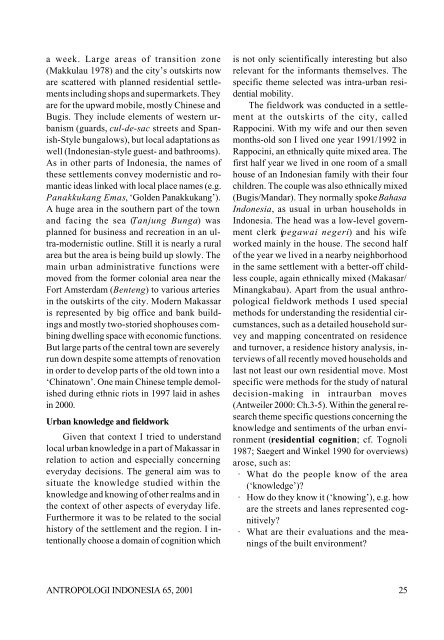Transethnic Identity and Urban Cognition in Makassar: - Antropologi ...
Transethnic Identity and Urban Cognition in Makassar: - Antropologi ...
Transethnic Identity and Urban Cognition in Makassar: - Antropologi ...
Create successful ePaper yourself
Turn your PDF publications into a flip-book with our unique Google optimized e-Paper software.
a week. Large areas of transition zone<br />
(Makkulau 1978) <strong>and</strong> the city’s outskirts now<br />
are scattered with planned residential settlements<br />
<strong>in</strong>clud<strong>in</strong>g shops <strong>and</strong> supermarkets. They<br />
are for the upward mobile, mostly Ch<strong>in</strong>ese <strong>and</strong><br />
Bugis. They <strong>in</strong>clude elements of western urbanism<br />
(guards, cul-de-sac streets <strong>and</strong> Spanish-Style<br />
bungalows), but local adaptations as<br />
well (Indonesian-style guest- <strong>and</strong> bathrooms).<br />
As <strong>in</strong> other parts of Indonesia, the names of<br />
these settlements convey modernistic <strong>and</strong> romantic<br />
ideas l<strong>in</strong>ked with local place names (e.g.<br />
Panakkukang Emas, ‘Golden Panakkukang’).<br />
A huge area <strong>in</strong> the southern part of the town<br />
<strong>and</strong> fac<strong>in</strong>g the sea (Tanjung Bunga) was<br />
planned for bus<strong>in</strong>ess <strong>and</strong> recreation <strong>in</strong> an ultra-modernistic<br />
outl<strong>in</strong>e. Still it is nearly a rural<br />
area but the area is be<strong>in</strong>g build up slowly. The<br />
ma<strong>in</strong> urban adm<strong>in</strong>istrative functions were<br />
moved from the former colonial area near the<br />
Fort Amsterdam (Benteng) to various arteries<br />
<strong>in</strong> the outskirts of the city. Modern <strong>Makassar</strong><br />
is represented by big office <strong>and</strong> bank build<strong>in</strong>gs<br />
<strong>and</strong> mostly two-storied shophouses comb<strong>in</strong><strong>in</strong>g<br />
dwell<strong>in</strong>g space with economic functions.<br />
But large parts of the central town are severely<br />
run down despite some attempts of renovation<br />
<strong>in</strong> order to develop parts of the old town <strong>in</strong>to a<br />
‘Ch<strong>in</strong>atown’. One ma<strong>in</strong> Ch<strong>in</strong>ese temple demolished<br />
dur<strong>in</strong>g ethnic riots <strong>in</strong> 1997 laid <strong>in</strong> ashes<br />
<strong>in</strong> 2000.<br />
<strong>Urban</strong> knowledge <strong>and</strong> fieldwork<br />
Given that context I tried to underst<strong>and</strong><br />
local urban knowledge <strong>in</strong> a part of <strong>Makassar</strong> <strong>in</strong><br />
relation to action <strong>and</strong> especially concern<strong>in</strong>g<br />
everyday decisions. The general aim was to<br />
situate the knowledge studied with<strong>in</strong> the<br />
knowledge <strong>and</strong> know<strong>in</strong>g of other realms <strong>and</strong> <strong>in</strong><br />
the context of other aspects of everyday life.<br />
Furthermore it was to be related to the social<br />
history of the settlement <strong>and</strong> the region. I <strong>in</strong>tentionally<br />
choose a doma<strong>in</strong> of cognition which<br />
ANTROPOLOGI INDONESIA 65, 2001<br />
is not only scientifically <strong>in</strong>terest<strong>in</strong>g but also<br />
relevant for the <strong>in</strong>formants themselves. The<br />
specific theme selected was <strong>in</strong>tra-urban residential<br />
mobility.<br />
The fieldwork was conducted <strong>in</strong> a settlement<br />
at the outskirts of the city, called<br />
Rappoc<strong>in</strong>i. With my wife <strong>and</strong> our then seven<br />
months-old son I lived one year 1991/1992 <strong>in</strong><br />
Rappoc<strong>in</strong>i, an ethnically quite mixed area. The<br />
first half year we lived <strong>in</strong> one room of a small<br />
house of an Indonesian family with their four<br />
children. The couple was also ethnically mixed<br />
(Bugis/M<strong>and</strong>ar). They normally spoke Bahasa<br />
Indonesia, as usual <strong>in</strong> urban households <strong>in</strong><br />
Indonesia. The head was a low-level government<br />
clerk (pegawai negeri) <strong>and</strong> his wife<br />
worked ma<strong>in</strong>ly <strong>in</strong> the house. The second half<br />
of the year we lived <strong>in</strong> a nearby neighborhood<br />
<strong>in</strong> the same settlement with a better-off childless<br />
couple, aga<strong>in</strong> ethnically mixed (Makasar/<br />
M<strong>in</strong>angkabau). Apart from the usual anthropological<br />
fieldwork methods I used special<br />
methods for underst<strong>and</strong><strong>in</strong>g the residential circumstances,<br />
such as a detailed household survey<br />
<strong>and</strong> mapp<strong>in</strong>g concentrated on residence<br />
<strong>and</strong> turnover, a residence history analysis, <strong>in</strong>terviews<br />
of all recently moved households <strong>and</strong><br />
last not least our own residential move. Most<br />
specific were methods for the study of natural<br />
decision-mak<strong>in</strong>g <strong>in</strong> <strong>in</strong>traurban moves<br />
(Antweiler 2000: Ch.3-5). With<strong>in</strong> the general research<br />
theme specific questions concern<strong>in</strong>g the<br />
knowledge <strong>and</strong> sentiments of the urban environment<br />
(residential cognition; cf. Tognoli<br />
1987; Saegert <strong>and</strong> W<strong>in</strong>kel 1990 for overviews)<br />
arose, such as:<br />
· What do the people know of the area<br />
(‘knowledge’)?<br />
· How do they know it (‘know<strong>in</strong>g’), e.g. how<br />
are the streets <strong>and</strong> lanes represented cognitively?<br />
· What are their evaluations <strong>and</strong> the mean<strong>in</strong>gs<br />
of the built environment?<br />
25


